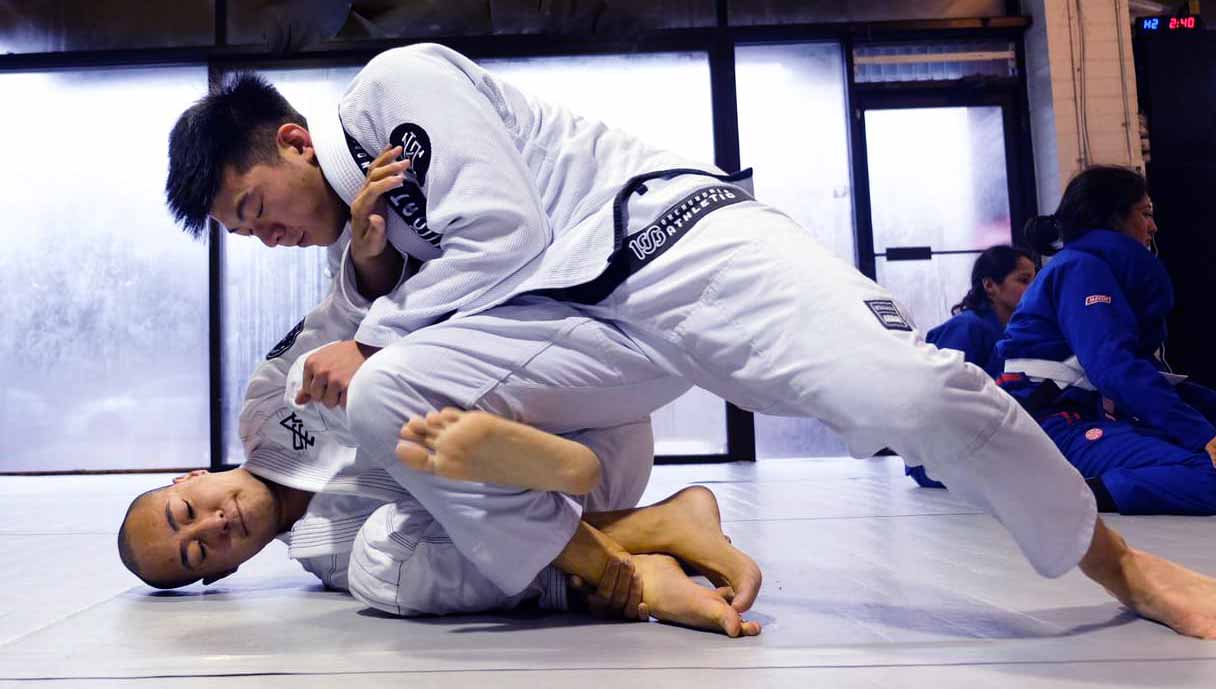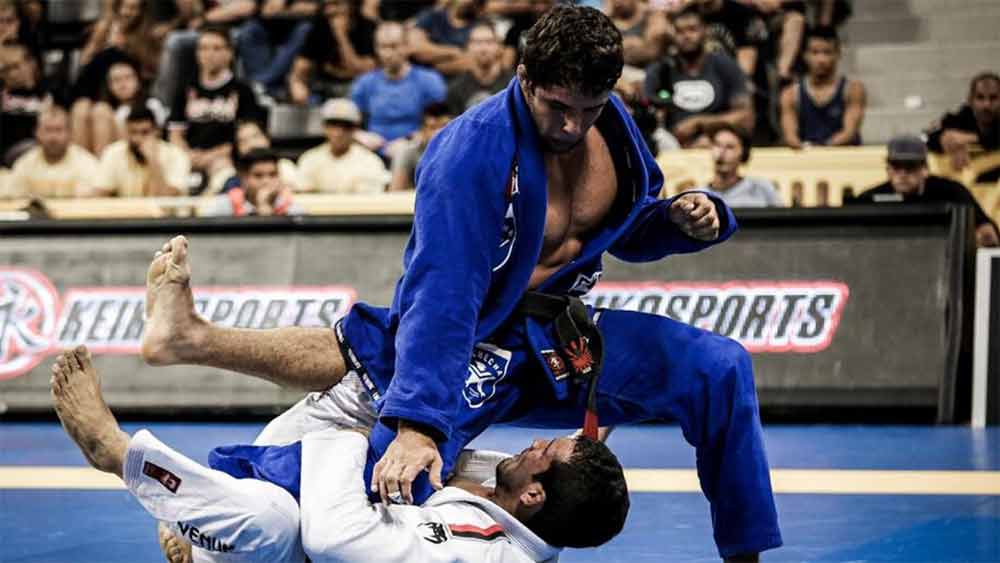
7 Basic Guard Positions Every New BJJ Player Must Learn
This article covers seven basic guards for BJJ that every grappler should have in their arsenal. Whether you train at the best Brazilian Jiu-Jitsu gym in Vancouver or simply roll for fun wherever you have access to mats, developing a good guard is crucial for your game as a jiu-jitsu player, fighter, and martial artist. The guard is as essential as it is iconic for Brazilian Jiu-Jitsu, and understanding the ins-and-outs of playing guard is crucial for any complete grappling game plan.
There are a massive number of guard types and variations for nearly every situation you might find yourself in on your back. In particular, the following 7 basic guard positions will offer you a solid arsenal of tools and tactics to avoid giving up the pass, while further threatening your opponent with powerful sweeps and devastating submissions. These guards are effective for BJJ with or without the gi, and together form a foundational system for countering many of the passes that you will find yourself facing. Whether you are training martial arts in Vancouver, Canada, or Rio de Janeiro, Brazil, you will come to see that the positions of BJJ are universal.

Closed Guard
Brazilian Jiu-Jitsu’s most basic guard, the closed guard is the clear place to begin our discussion. It serves as a simple, effective way to control your opponent, halt their forward momentum, and keep yourself out of harm’s way. As a beginner, you will quickly come to understand the importance of preventing your opponent from getting past your legs, such that wrapping and locking your legs around your opponent’s torso will become almost instinctive.
The closed guard is incredibly useful in almost any grappling context. From self-defense to sport jiu-jitsu and MMA, this foundational guard allows you to control distance and posture with the full leverage and power of both your lower and upper body. The closed guard also provides a base platform to launch a variety of sweeps and submissions, as well as offering some welcome opportunities to catch your breath following intense scrambles.
The biggest learning curve in closed guard is understanding how to use your legs and core in conjunction with your arms to off-base your opponent to set up attacks. Additionally, learning when to open your guard to initiate these attacks without your opponent escaping or worse, passing the guard, takes some time and practice.
Closed guard can often become a battle of attrition as your opponent works to hold your hips down, driving down their elbows and adjusting their own base to put pressure on your locked legs. A skilled closed guard player chooses when to maintain control and when to open and attack, rather than allowing the top player to grind them down and force them to open their guard. Taking the time to develop several high-percentage sweeps and submissions — such as the hip-bump sweep or the triangle choke — will eventually turn you into a deadly closed guard player. Further, and as we will discuss below, learning how to transition from closed guard to one of the many open guard variations vastly increases the threat you pose to the passing player.
Butterfly Guard
Butterfly guard is a common open guard style that can be employed against both kneeling and standing opponents. In the butterfly guard, you will use your shins (pushed against your opponent’s inner thighs) in conjunction with your feet (flexed up against the back of their thighs) to manipulate their position by lifting, pushing, and pulling their legs. This dynamic allows you off-balance and set-up sweeps, back-takes, and submissions against kneeling and standing opponents. The butterfly guard also allows for smooth transitions into other offensive guards such as half-guard, seated half-guard, and X-guard.
Traditional Half-Guard
In the past, half-guard was most often thought of as an intermediate position for the top player between passing the full guard and securing side control or mount. However, in the modern era of jiu-jitsu, half-guard has become an increasingly studied and practiced guard position in its own right.
Traditional half-guard involves having your legs wrapped around one of your opponent’s thighs with your feet or legs crossed firmly to block the passing player from freeing their leg and advancing position. Ideally, the bottom player will be sideways on one hip, facing the opponent.
In many cases, a well-established half-guard offers a greater number of attack options than the full guard position. In fact, a clever half-guard player may strategically allow the top player to pass into their half-guard in order to initiate a stronger offensive game plan. Half-guard offers several high-percentage sweeps ranging from old-school wrestling style back takes from the dogfight position to newer, flashier sequences such as the lockdown series.
As bottom player, you must watch out for submissions such as the d’arce choke when faced with a savvy attacker. Understanding the dynamics of pummelling for an underhook and avoiding getting flattened is crucial for stopping the guard pass, recovering full guard, and initiating your own attacks while avoiding any submission attempts.
Seated Half-Guard
Seated half-guard is a variety of half-guard initiated on a standing opponent. Instead of being on your hip with top player on their knees or sprawled out, you will be sitting on your butt with your knee-pit wrapped around a standing opponent’s ankle. The seated half-guard is a great counter when your opponent stands up in your guard or half-guard.
Generally speaking, the seated-half guard is used to initiate a variety of sweeps the rely on the mechanics of a single leg takedown. The seated-half guard is a great option for wrestlers due to the seamless transition into several effective single leg takedown attacks.
De La Riva Guard
Popularized by BJJ legend Ricardo de la Riva, the De La Riva guard is an open guard that involves weaving your leg behind the passing opponent’s leg on the same side, flexing your foot up around the thigh to establish a “De La Riva hook.” The foot of the non-weaving leg is generally placed on the opponent’s far hip, allowing for the “push-pull” dynamic that is so crucial to an effective guard. Your De La Riva hook can also be shoved even deeper through the opponent’s legs to hook the far hip, a position known as “deep De La Riva.” De La Riva guard offers a wide range of sweeps and back takes, and is a crucial step towards pulling off the berimbolo.
Though the De La Riva guard is traditionally a gi-focused guard due to its heavy reliance on a sleeve grip, it can be used effectively in no-gi as well for sweeps and entries.
X-Guard
Like the De La Riva guard, X-guard is an open guard variety that involves weaving your legs between your opponent’s. To initiate X-guard, your opponent must have passed a foot over your thigh in a standing position, such that his shin and foot are next to your hip. You need to cross your legs and extend them to the opponent’s far leg. You will then flex your feet to trap their far thigh between both of your flexed feet, allowing you to off-base the opponent to set up sweeps and transitions to other open-guards such as single leg X.
X-guard is a popular counter to an opponent standing up from your closed or butterfly guard, and can be readily imposed on opponents with a strong base and staggered stance.
Single Leg X-Guard
Like full X-guard, nowadays single leg X-guard is often taught to relatively new players due to the popularity of leg attacks — in particular the straight ankle lock — at all levels of competition. Single leg X-guard tends to be a bit more straightforward than full X-guard, and as such may be taught prior to additional X-guard positions and techniques.
In single leg X-guard, you must be underneath the top player with one of their feet to the outside of your hip. You will invert onto your back, with the same side leg wrapped around the standing player’s leg, heel firmly dug into the front of the opponent’s hip. The knee on your other leg will be pinching the standing player’s thigh against your wrapped leg, allowing you to apply sideways and diagonal pressure to your opponent’s leg and knee-line. From here you can keep them off-balance, pushing them forward or dropping them to their butt and attacking a straight ankle lock from the ashi garami position.
You can enter single leg X-guard nearly anytime your opponent stands up. Seated half-guard, as well as butterfly guard, offer great entries to single leg X on a standing opponent. If faced with a savvy opponent, single leg X also allows entry to other guard positions and leg entanglements such as full X-guard and honey-hole.
Playing Guard
As a beginner, training BJJ to effectively employ these guard positions will take time, dedication, and focused training. If you prefer to be on top, you may have to commit to focusing on just pulling and playing guard during live rolls. Furthermore, if you find yourself spending your rolls battling to keep your guard closed at all costs, as many beginners do, you should force yourself to open your guard and attempt some of the additional positions beyond closed guard.
Your guard will be passed frequently at first, however once you develop the fundamentals of good closed and open guards, you will be able to frustrate and stymie even the more pressure-heavy guard passers from the best BJJ gyms in town.
Sign up for your FREE TRIAL now.
